


Behind the Wire
Baseball Players Who Were Prisoners of War in WWII
by Gary Bedingfield
In time of war prisoners are inevitable, and World War II saw more prisoners than any other conflict with 130,000 American and 10,000 Canadian soldiers interned by the Germans and Japanese between 1940 and 1945.
Their time “behind the wire” was often a struggle to overcome the reality of captivity, boredom and in some cases fear for their lives. For most POWs boredom was their biggest enemy, for with it came apathy and a lowering of morale. As a result, sport was often the tool that helped overcome this problem, as American and Canadian servicemen used baseball as an ideal morale booster and to recreate a little piece of home.
Kriegsgefanger is the German word for prisoner, and this was affectionately abbreviated to Kriegie by Allied prisoners of war. The Canadians were the first baseball-playing Kriegies to be detained by the Germans with many airmen being taken prisoner during the Battle of Britain in late summer 1940. The first American troops to fall into the hands of the Germans were the ground forces captured in North Africa at the beginning of 1943, and a young minor league catcher named Mickey Grasso was among them. Then in the second half of that year Army Air Force crewmen – shot down over enemy territory – began to fill the Axis POW camps.
At many prison camps in Germany, athletic equipment that was actively collected by the YMCA in the United States, was distributed by the International Red Cross. It is claimed that 1,754, 254 pieces of sports equipment were shipped from the United States to Europe covering a range of sports including basketball, volleyball, handball, ping-pong and, of course, baseball and softball.
Ball games were a regular occurrence during the summer months, with their limited supply of equipment which often included crudely made bats and balls, informal games of catch, pick-up games and even organized league play took place, often encouraged by camp commanders as a means of maintaining morale and discipline. At Stalag Luft VIIA in Moosburg, Germany for example, a camp baseball league existed with many games between the Wildcats, Bomber Aces and Luftgangsters. Stalag IIIB in Furstenburg, Germany went a step further and had major and minor leagues divided into National and American divisions.
But baseball – on a much smaller scale – also served another purpose with the camps. The typical noise generated by the spectators and players at a ball game was sometimes used to disguise the sounds emitting from the excavation of escape tunnels. There are also reports of radio transistor parts being smuggled into prison camps inside baseballs and softballs.
By the beginning of 1945 conditions in prison camps had changed for the worst. Food rations dwindled, and at the hands of their captors most endured forced marches in freezing temperatures escaping the advancing Russians from the East, and British and Americans from the West.
During April and May 1945, German prison camps were liberated and North American servicemen – some in captivity for over two years – began the long but much welcome journey home.
![]()
In Japanese camps, where conditions and treatment varied drastically and an estimated 40% of Allied prisoners died in captivity, baseball’s role in the lives of Allied prisoners held a much lower ranking as food and survival took priority. Prisoners were used as slave labor, rest days were infrequent and many were often worked to death.
But unlike Germany, Japan was a baseball-playing nation with the game being introduced to the nation as long ago as the 1870s. While America and Japan were at war both countries had professional baseball leagues. It was not until late 1944 that Japanese professional baseball finally shutdown for the duration as the tide of war turned against the nation.
Therefore, with a country so fond of baseball there inevitably are accounts of baseball being played in some form, and in camps where discipline was a little more relaxed there are accounts of pick-up games played by American prisoners against their Japanese captors.
![]()
So, how many major league and minor league players were POWs in WWII? There is no official record. The following is probably the most extensive list ever produced, and yet I am sure many names are missing. As an often overlooked element of wartime baseball, theirs is a story of struggle to overcome the reality of captivity, boredom and in some cases fear for their lives. For the first time, these are the stories of the players who spent much of the war behind the wire.
![]()
Andy Anderson - POW at Stalag IXB (German) – 1944 to 1945
US Army
Infield
St Louis Browns
1948 to 1949
Anderson played
in the St Louis Browns’ organization in 1941 and 1942. He entered
service with the Army in November 1942 and served overseas in
Europe. He was captured by German forces on November 21, 1944 while
suffering a debilitating case of frostbite. Anderson was held at
Stalag IXB in Bad Orb Hessen-Nassau, Germany. When he was liberated
on May 4, 1945, his weight had dropped from 185 pounds to 125.
Anderson finally
made it to the major leagues with the St Louis Browns in 1948.
Read the full Andy Anderson biography
Frank Aten - POW at Oflag 64 (German) – 1944
to 1945
Captain
Field Artillery
US Army
Minor Leagues
Aten played in
the East Texas League before enlisting with the Army in August 1941.
He served in Europe with a field artillery unit and was captured by
German forces in 1944.
Aten was held at
Oflag 64 in Poland and was liberated in 1945.
Jim Blackburn - POW at Stalag IVB (German) –
1944 to 1945
7th
Armored Infantry Battalion US Army
Pitcher
Cincinnati Reds
1948 and 1951
Signed by the
Cincinnati Reds in 1941, Blackburn was pitching for the Syracuse
Chiefs of the International League before entering military service
in March 1944. He was the squad leader of a light-machine outfit
when he was wounded and captured by German forces on December 23,
1944. Blackburn was taken to Stalag IVB in Muhlberg Sachsen,
Germany, where his weight dropped by 75 pounds and he was forced to
march from one prison camp to another as the Allied forces
approached.
During this time,
Blackburn collapsed from weakness and malnutrition. Hospitalized by
his captors and too weak to move, an Allied bomber dropped its
payload close to the hospital. This act so outraged a German guard
that he obtained a pair of pliers and pulled out Blackburn’s
toenails as a means of torture and retaliation.
He was liberated
by the 69th Infantry Division in April 1945 and stayed at
hospitals in France and the United States before returning to the
Syracuse team for spring training in 1946.
Blackburn
eventually made it to the major leagues with the Cincinnati Reds in
1948.
Read the full Jim Blackburn biography
Walt Brickner - POW (German) – 1944 to 1945
Private
US Army
Outfield
Minor Leagues
Brickner first
played minor league baseball in 1939 with Dover in the Eastern Shore
League. He went on to play with Moultrie and Harrisburg before
entering military service in January 1942.
Serving with the
Army in Europe, Brickner was captured by the Germans and spent two
years in a POW camp. Upon his return to the United States he played
with the Idaho Falls Russetts of the Pioneer League in 1946, but in
September, while walking to town with two teammates, he collapsed
and was taken to hospital where he remained unconscious for four
hours. It was almost certainly due to the run-down condition he was
in after serving as a POW.
Augie Donatelli - POW at Stalag Luft IV
(German) – 1944 to 1945
379th
Bomb Group US Army Air Force
Umpire
National League
1950 to 1973
Donatelli had a
very brief career as a minor league infielder in 1938 before going
to work alongside his father and brothers in the coalmines of
western Pennsylvania. He entered military service with the Army Air
Force in January 1942 and was stationed in England with the 95th
Bomb Group as a tail-gunner on a B-17 Flying Fortress.
Donatelli flew 17
successful missions, but on March 4, 1944, during the first American
raid on Berlin, his plane was shot down. Parachuting to safety he
landed badly, broke his right ankle and was quickly captured by
German troops. He spent 14 months at Stalag Luft IV and tried to
escape twice but was recaptured.
He began umpiring
softball games while a POW and would enjoy a 24-year career as a
professional umpire after the war. Donatelli was liberated by
advancing Russian forces on May 12, 1945.
Read the full Augie Donatelli biography
Mickey Grasso - POW at Stalag IIIB (German)
– 1943 to 1945
168th
Infantry Regiment, 34th Infantry Division US Army
Catcher
New York Giants
1946; Washington Senators 1950 to 1953; Cleveland Indians 1954; New
York Giants 1955
Grasso played one
season of minor league baseball with Trenton of the InterState
League before entering military service with the Army on January 20,
1942. He served with the 34th Infantry Division in North
Africa and was taken prisoner by Rommel’s Afrika Korps on February
17, 1943. Grasso was among 6,000 Allied prisoners taken by the
retreating Germans who were being chased out of North Africa by
British forces.
After he was
captured, Grasso was marched three days to an airfield where he was
flown with other prisoners to Italy. They were then loaded into box
cars for a five-day journey to Stalag IIIB in Furstenburg, 60 miles
southeast of Berlin, Germany.
Grasso remained a
POW for two years but baseball was never far from his mind and
together with fellow prisoners Harold Martin (a former Appalachian
League outfielder) and Keith Thomas, they devised a baseball game
using playing cards which kept them entertained during the long
periods of boredom in the winter months.
During the summer
of 1943, competitive fast-pitch softball leagues were formed and
Grasso was a star player with the Zoot Suiters. The following
summer, there were major and minor league within the camp, divided
into National and American League divisions. Games were well
attended, the level of play was high and culminated in a World
Series in August.
In the final days
of the war, surviving on a daily diet of thin soup and a slice of
bread, and being marched towards Denmark after the Russian troops
broke through, Grasso and nine other prisoners slipped away into a
field when they stopped for a rest. Led by a Jewish POW who spoke
German, the prisoners marched through villages in columns of two
pretending to be a working detail. They eventually crossed the River
Elbe in a rowboat where they were greeted by troops of the 35th
Infantry Division.
Grasso returned
home on the Queen Elizabeth and played for the Jersey City Giants in
1946, making his major league debut with the New York Giants in
September.
Read the full Mickey Grasso biography
Dale Hills - POW at Stalag VIIA (German) –
1944 to 1945
Private
US Army
Pitcher
Minor Leagues
Hills signed a
professional contract in 1942 and pitched for Johnson City,
Huntington, Williamson and Asheville before entering military
service with the Army in February 1943. He served in Europe and was
captured in France by German troops on July 8, 1944.
Hills was
detained at Stalag VIIA in Moosburg, Germany and was liberated on
April 12, 1945.
Dixie Howell - POW at Stalag VIIA (German) –
1944 to 1945
60th
Infantry Regiment, 9th Infantry Division US Army
Pitcher
Cleveland Indians
1940; Cincinnati Reds 1949; Chicago White Sox 1955 to 1958
Howell first
played professional baseball with the Logan Indians of the Mountain
State League in 1937. He joined the Cleveland Indians and pitched
three games in 1940. Purchased by Cincinnati in 1943 he entered
military service in November of that year and served with the 9th
Infantry Division in Europe.
Crossing the
River Meuse in small boats, Howell was one of 150 American troops
captured by German forces. He was taken to Stalag VIIA at Moosburg,
Germany where he was held until liberated by advancing Allied forces
in April 1945. By that time Howell’s weight had dropped by 75
pounds.
He pitched for
Syracuse in 1946 and returned to the major leagues with Cincinnati
in 1949.
Read the full Dixie Howell biography.
Don Kirby - POW at Stalag Luft VI (German) –
1944 to 1945
Technical
Sergeant
452nd
Bomb Group US Army Air Force
Catcher
Minor Leagues
Kirby played for
Johnson City of the Kitty League before enlisting with the Army Air
Force in October 1942. He served as a radio operator with the 452nd
Bomb Group in England and his B-17 Flying Fortress was shot down
over France on a mission to Frankfurt on February 8, 1944.
Kirby was quickly
captured by German troops and sent to Stalag Luft VI at Hydekrug,
Germany. He played softball during the summer months and boxed in
the winter. In fact, boxing was something he became so good at he
represented the American servicemen in regular bouts against the
British and Canadian troops at the camp. In addition to athletic
pursuits, Kirby also attempted escape on two occasions but was
captured both times.
He was liberated
by advancing British forces in mid-1945 and returned to the United
States to play baseball for Muncie in the Ohio State League.
Walt Lentz - POW at Rangoon (Japanese) –
1944 to 1945
Staff Sergeant
45th
Bomb Squadron, 40th Bomb Group US Army Air Force
Pitcher
Minor Leagues
Lentz was 13-8 as
a North Carolina State League pitcher in 1942, and entered military
service with the Army Air Force in September of that year. He served
as a waist gunner in a B-29 Superfortress based at Chakulia in
India. On December 14, 1944, his plane was severely damaged while
bombing the rail yards in Rangoon, Burma.
Lentz and the
rest of the crew bailed out and were handed over to Japanese troops
by Burmese villagers. They travelled to Rangoon by boat, train,
truck and on foot, and were continuously interrogated. On one
occasion, Lentz refused to answer questions and was beaten to his
knees by a Japanese officer using a sword, Lentz thought he was
going to be beheaded but instead the officer thrust the sword point
in the young airman’s back and screamed at him that he would
thereafter answer the questions he was asked.
Lentz and the
rest of the crew arrived at Rangoon Central Prison on Christmas Day
1944. Conditions were poor. Four men shared a cramped cell where
they slept on pieces of burlap. They were frequently beaten by the
guards and everyone was soon suffering from malaria and severe
weight loss due to the poor diet.
More than four
months passed before Lentz and other prisoners who were able to walk
were marched to another camp. Along the way they were frequently
attacked by British fighter planes and, upon arriving at the village
of Pegu, they were abandoned by the Japanese guards.
Lentz was taken
to hospital and eventually returned to the United States. Recovering
from his ordeal he pitched for the Tulsa Oilers in 1946.
Read the full Walt Lentz biography
Ray Makepeace - POW at Manila and Osaka
(Japanese) – 1942 to 1945
Staff Sergeant
60th
Coastal Artillery US Army
Pitcher
Minor Leagues
Makepeace spent
two years in the Civilian Conservation Corps in northern Minnesota
before signing with the St Louis Cardinals’ farm team at Union City
in the Kitty League in 1937. A sore arm brought an early end to his
career but he continued to play and manage at the amateur level and
attempted a comeback with Sioux Falls of the Nebraska State League
before entering military service in February 1941.
Makepeace arrived
in the Philippines with the Army in April 1941, and was with the 60th
Coast Artillery based on Corregidor island in Manila Bay. Following
the attack on Pearl Harbor the Japanese aimed to conquer the
Philippines. The
Battle for Corregidor was the culmination of this campaign. When the
garrison on Corregidor surrendered on May 6, 1942, 11,000 American
and Filipino servicemen were incarcerated.
Makepeace was
given temporary duty repairing boats in Manila harbor before being
assigned to Manila Port Detail as part of 400 men responsible for
unloading and loading Japanese ships. There was little time to rest
but Makepeace was involved in occasional softball games using mainly
improvised equipment.
He was later
assigned to galley duty and was watching Japanese soldiers playing
baseball one day. A ball rolled to his feet and he bent down to pick
it up and return it to the players. In broken English, a soldier
asked Makepeace if he knew Ted Williams. “Yes,” he replied. He was
then asked if he knew Babe Ruth, and Makepeace said he knew him too.
The soldier smiled and said, “Fuck Babe Ruth!”
Makepeace was
later shipped to Japan and spent the remainder of the war at Osaka
Main Camp. He was liberated following the Japanese surrender.
Phil Marchildon - POW at Stalag Luft III
(German) – 1944 to 1945
433 Squadron
Royal Canadian Air Force
Pitcher
Philadelphia
Athletics 1940 to 1942, 1945 to 1949; Boston Red Sox 1950
Canadian-born
Marchildon joined the Philadelphia Athletics in 1940. He won 17
games in 1942 and entered military service with the Royal Canadian
Air Force after the season’s end.
Based in England
with 433 Squadron, Flying Officer Marchildon flew 25 successful
night-time missions as a tail-gunner on a Handley-Page Halifax
bomber. During the night of August 16, 1944, his squadron were
laying mines in Kiel Bay. He was four away from going home. As the
bomber flew through the darkness above the Baltic Sea on the way to
its target, it was attacked and set ablaze by a German night
fighter. In the spiralling chaos, the bomber's pilot immediately
gave orders for the crew to bail out - only the navigator and
Marchildon survived.
Stranded in the
icy water, both crew members were eventually picked up by a Danish
fishing boat and handed over to the German authorities. Marchildon
spent the following year at Stalag Luft III in Poland, where 350
prisoners were involved in a softball league. "I was a heavy-hitting
outfielder for the squad that won the camp championship," he later
said.
In the spring of
1945, as the Russians were advancing, the prisoners were marched to
Bremen. Then as the British and Americans got close the prisoners
moved again. As they marched on to a new prison site, the prisoners
were periled by their own Allies as planes swooped down in strafing
attacks. He was finally liberated on May 2, 1945. By this time he
was severely malnourished and had lost 30 pounds. He was flown back
to England to recuperate then returned to Canada by boat.
Marchildon was
suffering recurring nightmares, his nerves were in tatters and, not
surprisingly, he had no interest in returning to baseball. However,
the persuasive Athletics' owner, Connie Mack, eventually talked
Marchildon into joining the team and he made three brief appearances
before the close of the 1945 season.
He returned to
form the following season and won a career-high 19 games in 1947.
Read the full Phil Marchildon biography
Harold Martin - POW at Stalag IIIB (German)
– 1943 to 1945
Corporal
39th
Infantry Regiment 9th Infantry Division US Army
Catcher/Outfield
Minor Leagues
Martin was signed
by the Cincinnati Reds as a catcher and outfielder in 1940. He
played for Lenoir, Hickory and Greeneville before entering military
service with the Army in October 1941.
Martin served
with the 39th Infantry Regiment in North Africa. He was
wounded in combat twice and received the Bronze Star before being
captured by the Germans during the Battle of the Kasserine Pass in
Tunisia.
He was
transported to Germany and held at Stalag IIIB in Furstenberg, where
he remained for 26 months. Also at the camp was minor league catcher
Mickey Grasso and together with another prisoner, Keith Thomas, they
devised a baseball game using playing cards which kept them
entertained during the long periods of boredom in the winter months.
During the summer
of 1943, competitive fast-pitch softball leagues were formed with
Martin taking part. The following summer, there were major and minor
league within the camp, divided into National and American League
divisions. Games were well attended, the level of play was high and
culminated in a World Series in August.
Martin was
finally liberated in April 1945. He returned home and later served
with the Army in Korea and Vietnam.
Read the full Harold Martin biography
Ray Milcsik - POW at Stalag 17B (German) –
1944 to 1945
Sergeant
326th
Bomb Squadron, 92nd Bomb Group US Army Air Force
Shortstop
Minor Leagues
Milcsik played shortstop with the Cordele Reds in the
Georgia-Florida League after graduating from high school in New
Jersey in 1940. He entered military service with the Army Air Force
in January 1943 and served with the 92nd Bomb Group in
England. On January 4, 1944, he was the tail gunner on B-17 Flying
Fortress “Sweet Sixteen” that was hit by anti-aircraft fire over
Kiel, Germany. The bomber crashed at
Vinkwijk in Belgium and the crew were taken prisoner by the
Germans. Milcsik spent the next 17 months as a prisoner at Stalag
17B in Braunau Gneixendorf, near Krems, Austria.
Upon his return to the United States he tried to pick-up his
baseball career, playing with the Erie Sailors, an affiliate of the
New York Giants in the Middle-Atlantic League. Milcsik later joined
the Edison (New Jersey) police department and became a detective
lieutenant.
Bill Moisan - POW at unknown camp (German) 1945
Technician Fifth-Grade
Company G, 398th Infantry Regiment, 100th Infantry Division US Army
Pitcher
Major Leagues
Technician
Fifth Grade Moisan served in France in 1944, and was part of the
Allied advance into Germany in early 1945, earning the Silver Star
at Jagstfeld, Germany. He also received the Bronze Star and Purple
Heart.
He was
later captured by the Germans and as a Prisoner of War endured a
32-day forced march across Germany into Austria. Moisan suffered
frozen feet and his weight dropped from 185 pounds to just 95
pounds.
When he was
discharged in December 1945, his feet were so tender that he was
unable to cope with the infield work required around first base, his
normal position, but still wanted to pursue a career in professional
baseball and made
it to the majors with the Cubs in 1953.
Read the full Bill
Moisan biography
Joe Palatas - POW at Stalag IIA (German) –
1944 to 1945
325th
Bomb Squadron, 92nd Bomb Group US Army Air Force
Outfield
Minor Leagues
Palatas played
one season in the minor league with the Springfield Red Birds of the
Mid-Atlantic League in 1942. Shortly after the season ended he
entered military service with the Air Force and was stationed in
England with the 92nd Bomb Group.
Flying as
bombardier on a B-17 Flying Fortress, Palatas’ plane was shot down
by antiaircraft fire over Stettin, Germany on April 11, 1944.
Severely wounded, he managed to bail out of the stricken craft.
Immediately upon landing he was taken prisoner by German troops and
transported to the hospital at the Stalag IIA prison camp in
Altengrabow, Germany. Palatas succumbed to his wounds later that
day.
Read the full Joe Palatas biography
Pete Petropoulos - POW in France (German) –
June 7 to June 19, 1944
Company D,
22nd Infantry Regiment, 4th Infantry Division, US Army
Pitcher
Minor Leagues
Petropoulos was a
batting practice pitcher with the Brooklyn Dodgers in 1938. He
signed a professional contract in 1939 and was assigned to the
Daytona Beach Islanders of the Florida State League, where he posted
a 10-9 won-loss record. In 1940, Petropoulos was with the Fort
Lauderdale of the Florida East Coast. He had a 7-4 record as a
pitcher and also played first base and the outfield.
In March 1941,
Petropoulos was drafted and entered military service with the Army.
He left the safety of the United States in January 1944 and arrived
in England as part of the D-Day invasion build-up with the 4th
Infantry Division.
On June 6, the 4th
Infantry Division landed at Utah Beach in Normandy, France, and the
following day he was badly wounded by an exploding enemy artillery
shell. He suffered severe leg wounds and was picked up by German
troops, being held prisoner without food or medical aid in
Montebourg, France. Eleven days later, on June 19, Petropoulos was
repatriated when Allied troops overran the town.
Petropoulos was
shipped back to the United States with a Silver Star and Purple
Heart. He recuperated at Rhoads General Hospital in Utica, New York,
and underwent seven major operations. His playing days were over but
Petropoulos went to work for the New York Giants as a scout, and in
1948 he became a goodwill ambassador to servicemen and veterans,
conducting The Sporting News Sports Caravan, which, in
conjunction with Liggett & Myers - the makers of Chesterfield
cigarettes - visited veterans’ hospitals in the New York
metropolitan area.
This tour was
later expanded to take in veterans’ hospitals in southern states,
and for 12 years Petropoulos managed the Chesterfield-Sporting
News (later Chesterfield Satisfiers) baseball team that played
at veterans’ hospitals.
Read the full Pete Petropoulos biography
Armand Sergiacomi - POW at Stalag Luft IV
(German) – 1944 to 1945
Corporal
766th
Bomb Squadron, 461st Bomb Group US Army Air Force
Shortstop
Minor Leagues
Sergiacomi, a
shortstop in the Yankees’ organization, had signed with Butler in
1939. He played at Amsterdam, Akron, Norfolk, Binghamton and Newark
before entering military service with the Army Air Force in 1943.
Sergiacomi was
assigned to the 461st Bomb Group at Torretta Field in
Italy on August 18, 1944. On the 26th of that month he
was aboard a B-24 Liberator that was part of the first Allied
bombing run over Yugoslavia. The target that day was the Otopeni
Airfield near Bucharest which was being used by the Germans.
Sergiacomi’s
bomber was damaged over the target and the crew were forced to bail
out. He was quickly taken prisoner by German troops and transported
to Stalag Luft IV at Gross-Tychow in Poland.
On February 6, 1945, because of the
advancing Russian army, the 8,000 Allied prisoners at Stalag Luft IV
were evacuated in what would become known as the Black March. The
march lasted 86 days and covered and covered 500 miles in freezing
conditions. Many suffered frostbite, dysentery, dehydration,
starvation and even death.
They reached Stalag 357,
near Fallingbostel in Germany in early April 1945. But a week later,
with American forces rapidly approaching, they were on the move
again with little or no food. On the morning of May 2, 1945 the POWs
were resting next to the Elbe River near Lauenburg, Germany when the
British arrived. It is estimated that as many as 1,300 Allied
prisoners had died since leaving Gross-Tychow.
Sergiacomi returned to professional baseball in 1946 but quit
shortly after the season started and went to play for the Arma AA
semi-pro team in the Metropolitan Baseball Association in New York.
Bert Shepard - POW at Stalag IX-C (German) –
1944 to 1945
55th
Fighter Group US Army Air Force
Pitcher
Washington
Senators 1945
In 1941, the
lefthander was pitching with the Bisbee Bees in the Arizona-Texas
League where he had a 3-5 won-loss record but was also a useful
utility player appearing at first base and in the outfield. By May
1942, Shepard was in military service with the Army Air Force.
Earning his
pilot’s wings as a fighter pilot, Lieutenant Shepard served with the
55th Fighter Group in England, flying low-level strafing
missions in a P-38J Lightning. Shepard had already flown 33 missions
when he was shot down while attacking an airfield near Ludwiglust,
east of Hamburg, Germany. His plane was hit by enemy flak, with
shells tearing through his right leg and foot. Shepard was knocked
unconscious and at 380mph the fighter plane crashed into the ground.
Shortly after
the crash landing, Ladislaus Loidl, a physician in the German
Luftwaffe, arrived at the smoking wreckage in time to save the
injured pilot from a group of irate farmers on whose land the plane
had crashed. Loidl, with the aid of two armed soldiers, drove the
farmers away and helped the pilot free. He was unconscious, his
right leg was smashed, and was bleeding from a deep wound on his
head. Shepard was in urgent need of medical attention and Loidl soon
realized his nearby emergency hospital was not equipped for what was
needed. Loidl got the pilot to a hospital where Shepard's damaged
right leg was amputated 11 inches below the knee.
After a long
period of recovery he was transferred to the Stalag IX-C prison camp
at Meiningen, in central Germany, and with the assistance of Doug
Errey - a Canadian medic and fellow prisoner who crafted a makeshift
artificial leg - Shepard was soon playing catch at the camp.
Shepard returned
to the United States on a prisoner exchange in February 1945. Whilst
at the Walter Reed Hospital in Washington, DC, he met with Under
Secretary of War, Robert Patterson, who asked about the disabled
airman’s plans for the future. Shepard did not hesitate to explain
that he wanted to play baseball and despite his own scepticism he
contacted Senators' owner, Clark Griffith, and asked if he would
take a look at the young pitcher.
Shepard arrived
at the Senators' spring training camp on March 14. On March 29, he
was signed as a pitching coach and pitched four innings against the
Dodgers in a War Relief Fund game on July 10. On August 5, 1945,
Bert Shepard – with an artificial leg - made his major league debut.
The Senators were down 14-2 to the Red Sox, when Shepard came in in
the fourth inning and struck out the first batter he faced, George
"Catfish" Metkovich. He pitched the remainder of the game and
allowed just three hits, one walk and one run. It was to be his only
major league appearance.
Shepard played
and managed in the minor leagues until 1954, and then took
employment as a safety engineer with IBM and Hughes Aircraft. In May
1993, Shepard had an emotional reunion with Doctor Loidl, the man
who had rescued him from the plane wreckage after he was shot down.
Read the full Bert Shepard biography
Dizzy Sutherland - POW (German) – 1943 to
1945
Pitcher
Washington
Senators 1949
Sutherland worked as a cab driver before entering military service
with the Army in January 1943. In September of that year he took
part in the airborne assault at Salerno, Italy. His battalion was
mis-dropped behind German lines and Sutherland was wounded three
times before being captured. He spent the remainder of the war in a
POW camp in Germany and by the time he was liberated in 1945 his
weight had dropped by 100 pounds.
Sutherland returned home to Washington, DC where continued to drive
a cab and play semi-pro baseball at the weekend. But in 1949, at the
age of 27, he was signed to pitch for the Charlotte Hornets – a
Washington Senators’ farm team in the Tri-State League.
Sutherland had an outstanding rookie season with the Hornets,
posting an 18-10 won-loss record with a 3.22 ERA. He was called up
to the Senators in September 1949, and made his only major league
appearance on September 20, 1949 in a start against the St Louis
Browns. He was taken out in the second inning with the bases loaded
and none out, having given up eight runs on two hits and six walks
and was charged with the loss.
Sutherland returned to Charlotte in 1950 and though again recalled
by the Senators in September and with them for spring training 1951,
he did not make another appearance. Sutherland continued to pitch
for the Hornets in 1951 and ended his professional career with the
Richmond Colts in the Piedmont League in 1953.
Read the full Dizzy Sutherland biography
Loyd Taylor - POW at Oflag 64 (German) - 1944 to 1945
First Lieutenant
Company K, 179th
Infantry Regiment, 45th Infantry Division US Army
Shortstop
Minor Leagues
Taylor was a shortstop with Union City
in the Kitty League in 1941. He entered military service with the
Army the following year and saw action with the 45th Infantry
Division in Sicily and Italy.
On February 16, 1944, Lieutenant
Taylor was captured by German forces in Italy.
He was held at
Oflag 64 in Poland and was liberated in 1945.
Taylor returned home with a bronze
star and in 1946 he briefly attempted a comeback with Greenville in
the East Texas League.
Eugene
Wagner - POW in North Africa (French) – 1943
US Army
Minor Leagues
Wagner, who played with Beaver Falls of the Penn State League in
1940, entered military service in June 1941. He served with the Army
and was captured by Vichy French forces at Casablanca in November
1942. Days later he was released when the French forces surrendered.
Wagner went on to earn a Bronze Star in combat in Europe.
Stanford Wolfson - POW (German) – 1944
335th Bomb Squadron, 95th Bomb Group US Army
Air Force
Outfield/Infield/Pitcher
Minor Leagues
Wolfson played
baseball at the University of Illinois and signed with the
Springfield Cardinals of the Western Association in 1940. He played
almost every position on field and was with Cooleemee, Johnson City
and Union City before entering
military
service with the Army Air Force in October 1942. Wolfson trained as
a bomber pilot and was attached to the 95th Bomb Group in England.
Wolfson completed 18 missions flying a B-17 Flying Fortress. On
November 5, 1944, he was co-pilot on a mission to Ludwigshafen,
Germany. The bomber was heavily damaged by flak over the target area
and orders to bail out were given by the pilot.
Wolfson landed in the Pfalzer Wald Forest about 12 kilometers
southwest of Kaiserslautern. He handed himself in at the nearest
town and was picked up by members of the Criminal Police from
Kaiserslautern. On the journey to Kaiserslautern, Stanford Wolfson
was taken to a wooded area and shot dead. A trial was held by the
General
Military Government Court at Dachau,
in 1947, where Wolfson’s executor was given a life sentence.
Read the full Stanford Wolfson biography
And finally, I
may have uncovered the baseball team with the most former POWs in
their lineup. The July 16, 1945 sports page of the Atchison Daily
Globe described a game between a team of servicemen home on
furlough and the semi-pro Touslee Motors – played at Amelia Earhart
Stadium in Atchison, Kansas - in which six of the servicemen players
were former prisoners of war. In the four-inning game which ended in
a 5-5 tie, pitcher Frank Davis had been a former prisoner of the
Germans, Bill Biffinger – second baseman – had also been detained in
Germany. Shortstop Willie Thomas had been shot down over Burma and
was a prisoner of the Japanese. Centerfielder Bob Vogt had been
captured by the Germans, while Al Bracke and Bob Besinger – both on
the bench for the game – had been prisoners of the Germans.
Page added September 21, 2007
Further reading: I strongly
recommend Tim Wolter's POW Baseball in World War II (McFarland 2002
ISBN 0786411864) Copyright © 2013 Gary Bedingfield (Baseball
in Wartime). All Rights Reserved.
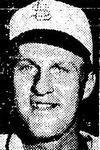
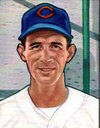
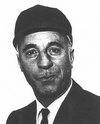
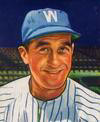
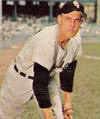
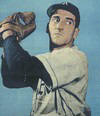

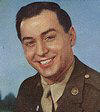
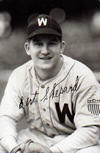
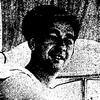
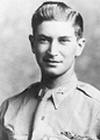
![]()